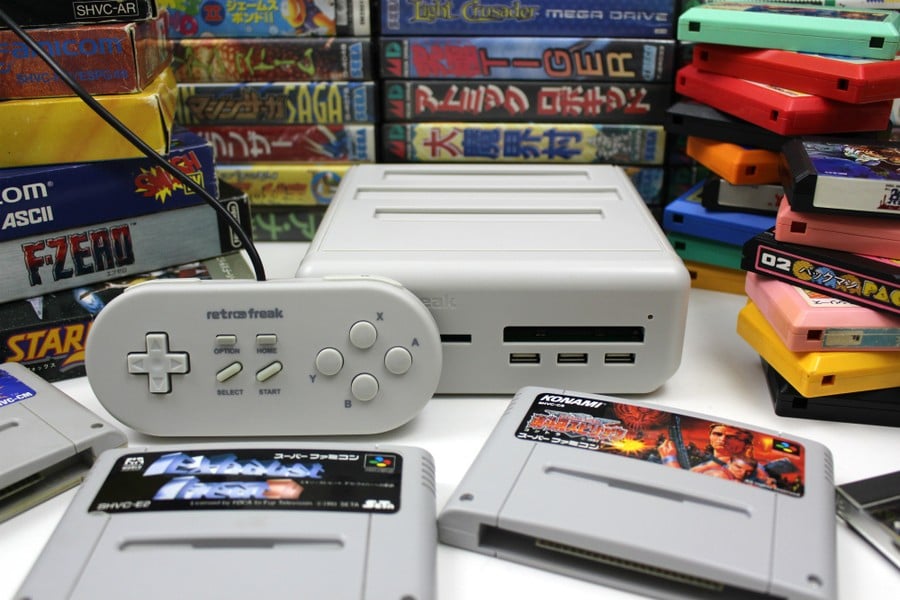
You should never underestimate the power of old games. When the Retro Freak was announced earlier in the year it triggered quite a stir online - a remarkable feat when you consider that the company behind it, Cyber Gadget, is a tiny and largely unknown Japanese outfit. The system's retro-gaming potential ensured that it set many chins a-wagging; support for Famicom, Mega Drive, SNES, Game Boy, Game Boy Advance and PC Engine cartridges - twinned with the ability to dump the games into internal storage, apply patches and even tinker with image filters - generated sizeable interest from classic and modern gamers alike.
Now the console is finally here, and it's time to see if the Retro Freak - currently available from Hong Kong video game specialist Play-Asia.com - can possibly live up to the hype which surrounded its unexpected announcement. Is this unit worth a look when Hyperkin's excellent - and very similar - Retron 5 is already available, or does it fail on all counts? You're about to find out.
Design & Build Quality
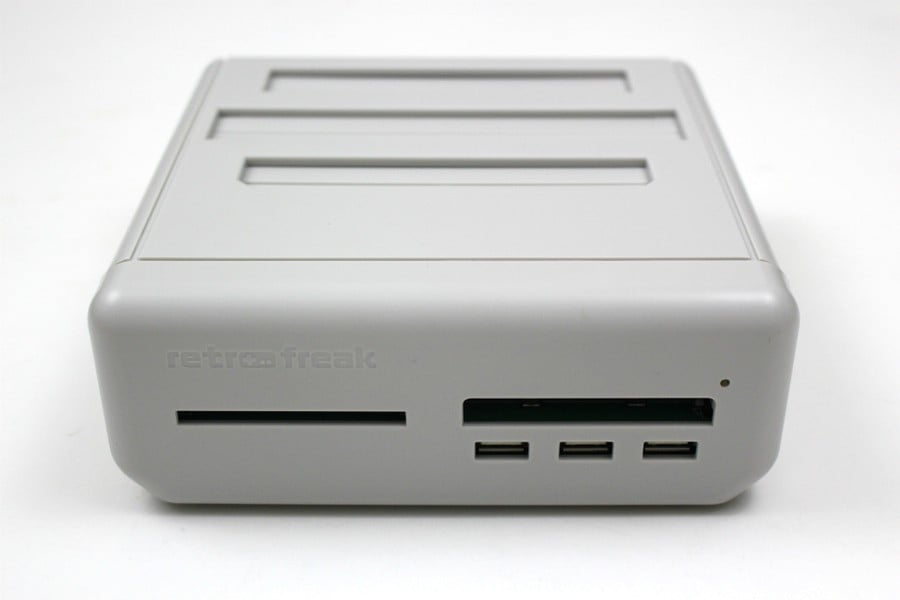
The Retro Freak's glossy, high-quality packaging makes a good first impression, and while the unit itself is perhaps a little underwhelming - it's a grey lump of plastic, basically - the build quality is decent enough. The console is actually made up of two sections, with the "brain" of the hardware being a small plastic unit about the same size as a game cartridge. This docks into the larger segment - the one which all the cartridge ports on it - to create the full system, but can be used totally independently.
On the top of the console you'll find slots for Famicom, SNES / Super Famicom and Mega Drive / Genesis games, while on the front there's the PC Engine / TurboGrafx-16 and Game Boy / Game Boy Color / Game Boy Advance slots. Strangely, the unit does not support NES carts out of the box, although we imagine some kind of adapter will make this possible. There are also three USB ports on the front of the system, which are used to plug in controllers and other accessories. On the back you'll find a HDMI socket and the power button.
The Controller
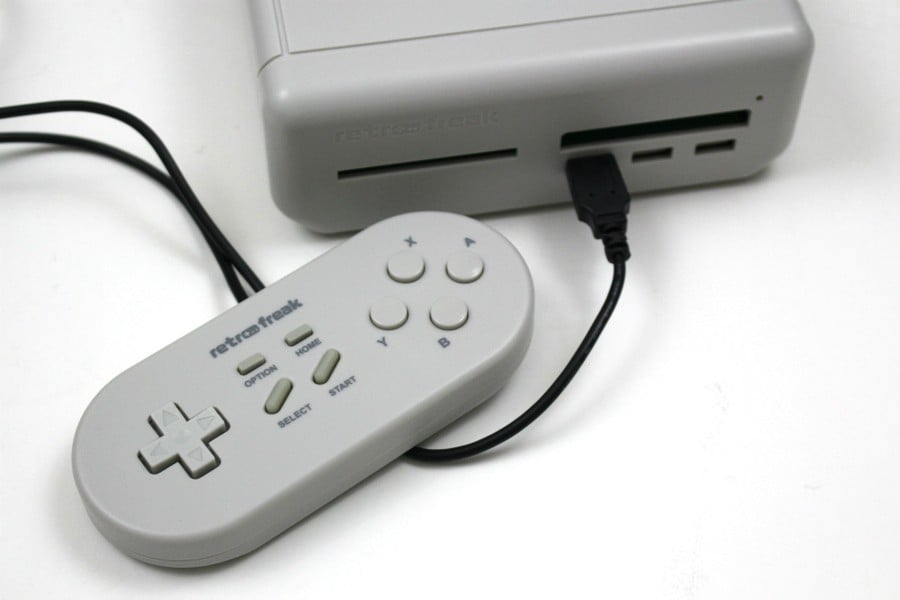
Bundled with the system is the Retro Freak controller, which is clearly inspired by the classic SNES pad. It has the same D-Pad, face button cluster and shoulder buttons, and is very similar in terms of shape and ergonomics. The biggest difference is that there are additional buttons in the centre of the pad - one is intended to return you to the console's main user interface while the other opens the in-game options menu. In our case, the "Home" button fires up the options menu while the options button didn't actually do anything. Pushing both of these buttons together creates a screenshot in PNG format.
As far as pads go, it's not a bad effort, and certainly more agreeable than the controller which shipped with the Retron 5. The D-Pad is slightly squishy but we didn't notice any issues with input - it picked up all of our presses and held up well when performing Dragon Punches in Street Fighter Alpha 3 on the Game Boy Advance. The pad is preconfigured to work with all of the supported systems, but you can tinker with the button mapping if you so wish.
The biggest shame is that the console only comes with a single pad, but you can plug in pretty much any USB controller if you're looking for some two-player action. All of the pads we tried worked without a hitch, including a USB adapter which allowed for original PlayStation and Saturn pads to be hooked up. The 8bitdo range of Bluetooth controllers work via a wired connection, as do the Sony PlayStation 3 and PlayStation 4 DualShock pads.
Taking this into account, the fact that the system only ships with a single controller is less of an issue. A deluxe version of the Retro Freak also includes a special adapter which allows you to plug in your original controllers (something the Retron 5 supports out of the box) but if you're anything like us then you'll already have a multitude of USB pads lying around the house which negates the need for this peripheral. Still, it's nice to at least have the option, even if it comes at an additional cost.
One final thing to note on the subject of controllers - the Retro Freak doesn't have Bluetooth so a cable-free interface solution sadly isn't possible, unless you invest in a Bluetooth transmitter, like the one sold by 8bitdo.
Software
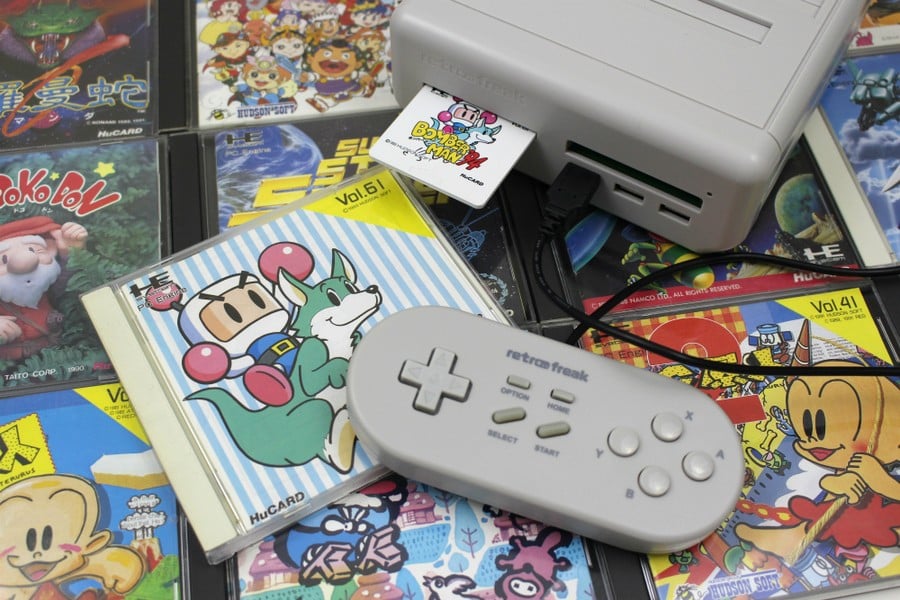
The Retro Freak uses Google's Android operating system, just like the Retron 5. It uses emulation to replace the performance of the supported consoles, "dumping" the game data from the original cartridge into the console's memory. Because it's emulated, you benefit from several improvements, such as the ability to save your progress wherever you are in the game or apply image filters to make the picture slightly different. You can also apply patches to titles - such as Japanese RPGs which have had unofficial English fan translations - and execute cheats to gain infinite lives or ammo. You can also import and export battery backed-up save data from games, which means your progress can be preserved forever - even after the battery in the cartridge has died.
The menu system is certainly a lot more attractive than the one we saw on the Retron 5, and everything is laid out in a logical fashion. Inserting a cartridge triggers a short load time as the console dumps the ROM data, and you're then presented with information on the game, such as its title, developer and release date. A secondary menu allows you to toggle cheats, mess around with AV settings and configure controllers before you actually load the game up.
The video options are pretty much identical to those on the Retron 5. You can apply image filters to smooth out the graphics, but to be brutally honest they all look terrible. We prefer to use an unfiltered image with the scanline overlay enabled. Scanlines - in case you were wondering - are the lines you get when you run any AV information through an old-fashioned CRT TV set. For many retro game enthusiasts they are an essential part of enjoying vintage games, as they make things seem more authentic. This is of course a matter of personal preference and if you've never gamed on a CRT screen then you may wonder what the fuss is about. In the case of the Retro Freak, the scanlines are in fact a transparent overlay which is placed on top of the main image. Because of this, they don't actually marry up with the pixels, which means it's not quite the same as using an actual CRT - but it's passable. It's certainly more appealing that the idea of having a gigantic CRT set in your house solely for playing old games on - something that simply isn't going to be feasible for casual retro players.
The firmware in the Retro Freak is upgradable, but because the console lacks wireless connectivity you'll have to perform a pretty laborious procedure which requires writing an update request to an MicroSD card via the console, inserting it into your PC, downloading the update and switching back to the console to execute the installation. The system doesn't inform you that an update is available - obviously, as it has no online connectivity - so you'll need to check the Retro Freak site periodically to see if one is on offer.
When the Retro Freak was first announced much was made of the console's ability to dump ROMs from the original carts and store them on a MicroSD card - a similar process to that seen on the Retrode 2, and something the Retron 5 does not natively support. The concept is simple - you dump all of your existing games using the machine and then detach the smaller section of the Retro Freak and take it to a friend's house. It's an instant portable game collection, and a pretty clever idea to boot.
However, by including such a feature, Cyber Gadget has rather compromised the concept of the system, because there's nothing stopping you from downloading a load of ROMs off the internet and dumping them on the MicroSD card - the system will recognise and load ROMs regardless of their origin, rather defeating the object of using your own cartridges. Of course, you don't have to dump your games to MicroSD when you play them, and out of the box there's actually no way of doing so - no MicroSD card is included, and one is required in order to store the ROMs. If you want to use your existing software and don't mind loading up games individually - just like the good old days - then you're still perfectly free to do that, but we fear a great many users will simply grab ROMs online and take the easier route.
Hackers are already exploiting the Retro Freak's Android architecture to open the system up to other types of emulation - including N64 and Mega CD - so in the fullness of time this could become quite a formidable retro-gaming platform.
Performance
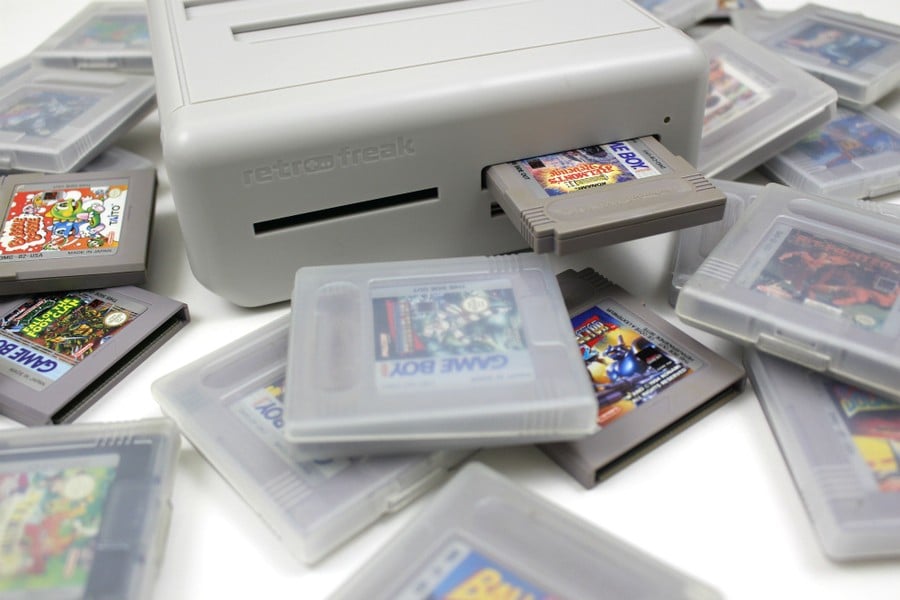
In terms of compatibility, the Retro Freak handled everything we threw at it. We tried multiple games across all of the supported formats and it recognised and ran then without any issue. The only time it struggled was when we inserted a pre-release review sample of Perfect Eleven on the Super Famicom, and even then it simply flashed up a warning to say that the game was unknown, but could still be loaded (and to be fair to the system, it probably can't be expected to recognise games that weren't publically available in this form).
While the console is advertised as supporting a wide range of systems, it's worth noting that it is also capable of playing Sega Master System games using a PowerBase Mini adapter. The Super Game Boy peripheral isn't supported, but some Game Boy games run with Super Game Boy borders, which removes the need for this additional piece of tech anyway. Everdrives and other flash carts do not work with the system, but that's not an issue when you consider how easy it is to get ROMs onto the device.

The emulation of each system is also excellent, with games running at full speed with no noticeable hiccups. The Retron 5 offered the same level of performance, which shouldn't be surprising as both systems use the same Rockchip 3066 "System on a chip" chipset. We noticed a bit of ghosting on some fast-paced games - usually ones with black-on-white visuals, like Game Boy titles - but this could be down to our LCD TV rather than the console itself. Audio is a slightly different story; while most games sound perfectly fine, there are a few which are noticeably different when compared to the original hardware. Mega Man 2 is one such example; some of the tunes sound a lot worse on the Retro Freak because the instrumentation isn't quite right. It should be pointed out that this is a very, very minor issue - the vast majority of the games we played sounded perfect - but it's worth noting if you're a purist who is expecting like-for-like replication of the entire experience. The only way to get that, ultimately, is by using the original hardware.
Conclusion
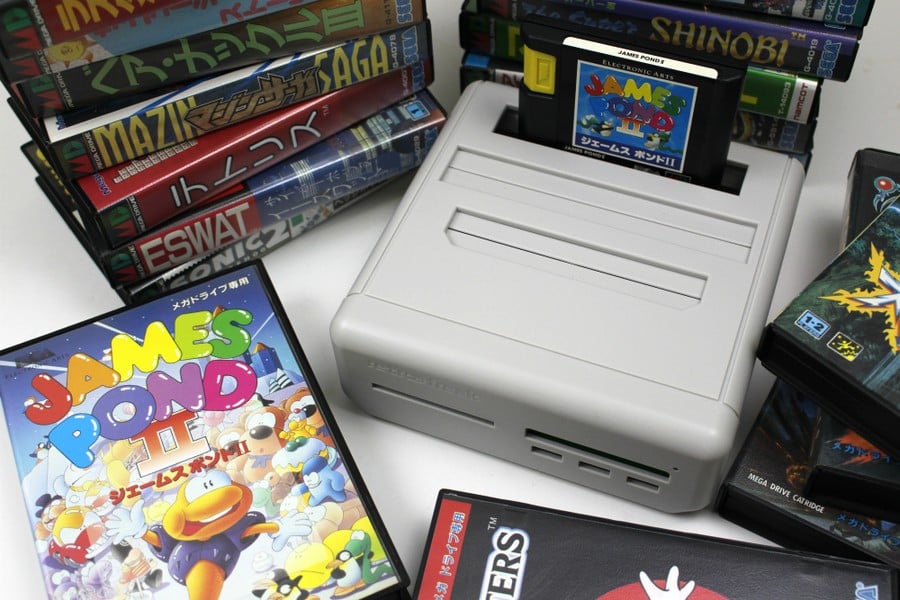
You'll no doubt have noticed that Hyperkin's Retron 5 has been mentioned several times during this review, and with good reason - it's currently the Retro Freak's only real competition in this sector of the market, is based on the same technology and - we assume - runs very similar software. On paper, Cyber Gadget's system has some distinct advantages over Hyperkin's; it runs PC Engine / TG-16 games, and will soon have support for Sega Gear Gear and Sega Mark III software thanks to a special adapter. It also allows you to dump ROMs to a MicroSD card so you only have to insert a game once, and the fact that it's a more portable unit (when unbolted from the cartridge adapter) means it's easier to take around to a friend's house than the Retron 5, which is something of a monster in terms of size.
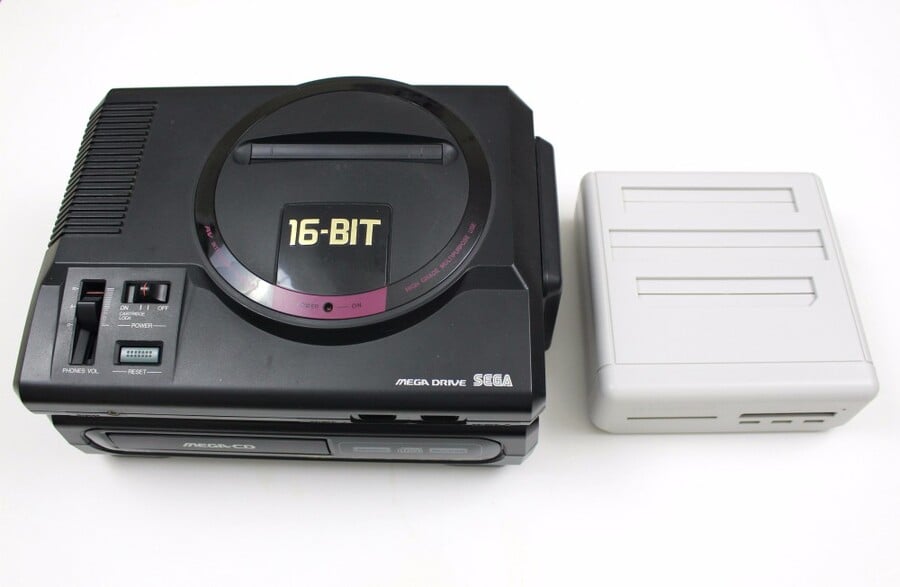
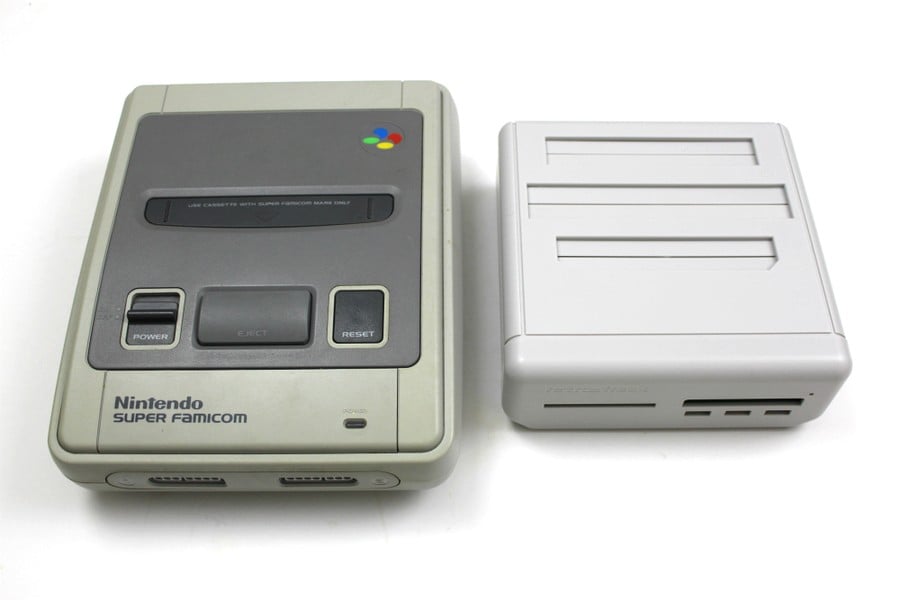
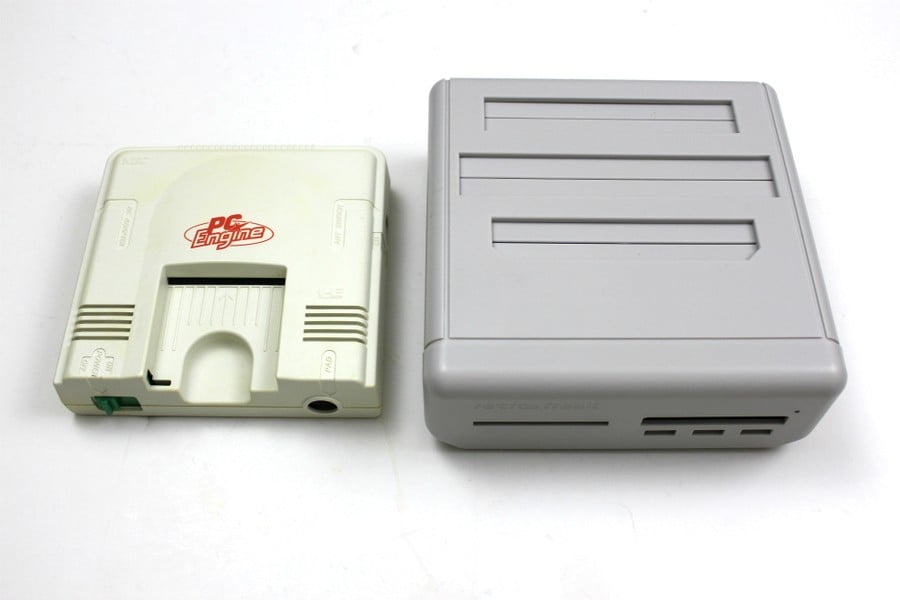
However, there are some drawbacks. The lack of Bluetooth support means you can't use wireless pads, and if you want to use your original controllers you'll have to invest in an additional adapter - the Retron 5, on the other hand, came with NES, SNES and Mega Drive controller ports built-in to its casing and wireless controller support. Wide-ranging compatibility with USB controllers mitigates this shortcoming to a degree, but it's a real shame that - out of the box, at least - you can't use your trusted pads which have served you so well over the years, unless of course you spend a bit more on getting the deluxe bundle.
On balance though, we feel that the Retro Freak is a more than adequate alternative to the Retron 5, and in many ways it's a superior purchase. It's smaller for starters, which makes it easier to slot next to your existing systems. If you're really space-conscious then you can remove the cartridge adapter altogether, creating an even more compact system. The user interface is much nicer to look at and easier to use, while the ability to dump ROMs offers advantages which surely need no explanation. The emulation isn't perfect - no emulation truly is, as any purist will go to great lengths to tell you - but for the average user it is likely to be almost indistinguishable from the real thing.
Thanks to Play-Asia.com for supplying the Retro Freak used in this review.
This article was originally published by nintendolife.com on Tue 8th December, 2015.






Comments 43
Didn't think I'd ever find myself saying this but I think I genuinely prefer the design of the Retron. The Retron's not going to be winning any beauty contests any time soon but it's more interesting that the dull, grey lump here. Having said that the additional functionality is certainly a positive, even if I lack any and all PC Engine, Game Gear, and Famicom games.
Looks like it's definitely worth considering if you want the extra functionality, but lacking proper NES support does make this a very Japanese-centric device.
If my Genesis and SNES stop working, I might get one of these. But I greatly prefer using an original console, even with having to use AV cables.
@AlexOlney this looks awesome, but no word on an NES adapter?
Way too bulky for my taste and without an NES cartridge slot, it's definitely a no for me. Also it cost over $300 to get it, I assume those emulator makers will be very pissed about this one too.
If it uses emulation, does that mean we wouldn't be able to play SNES Star Fox?
@leo13 It plays Star Fox, and all other Super FX games.
That's good to know! Thank you
The real question is: Is it compatible with the Famicom Disk System?
What I really want to know is if you can transfer your game paks saves to the system and back again. Would you be able to answer that? Thank you!
@Dr_Corndog SNES can stop working? I don't think so
You guys are forgetting one thing... A regular android phone and a Chromecast with a Madcatz control pad is also "competition" too.
@Damo Would it be able to play Star Fox and other special chip games like Super Mario RPG, Yoshi's Island, etc. straight from the micro SD card without the actual cartridge plugged in?
@artofmana Damn son, you can use Google cant you?
@Chandlero
I've got 5 model 1 SNESs in my basement that don't work. The PPUs are not functioning on 2 of them, one is water damaged, one doesn't play every games (It hates Mario Kart and Mario All-Stars + World) and the final one kills every fuse I put in it. The 64 however is a beast.
@hypermuffin Yep, you can do that.
@artofmana Yes, you can - I mentioned that in the review
Well, it's certainly not a looker. That console and controller...
PS. It never ceases to amaze me how small the original PC Engine was/is.
@damo Nice review.
From a Retron 5 owner, how is the "grip" on the cartridges? I'm on my second Retron 5 and scared everytime I wrestle out a cartridge.
@BF-Medic It's still a bit tighter than I'd like, but nowhere near as bad as the R5.
i for one am happy with my retron 5...clean games go in and out of the slot easyer...my retron 5 has been a great purchase...i cant wait for the next update...
I'm waiting for Retron N64 support, rather than emulation.
SEGA 32x support?
@ledreppe Doubt that will happen. They will probably stick to emulation from now on, considering the success of the Retron 5.. Heck even before that they were still using emulation, it was just hardware emulation rather than software.
Awesome piece of hardware, it's like a museum in a box.
To be honest , i stick with my wii for emulation purpose, but this certainly feel/looks closer to the real thing ^^
To play n64 games i suggest the real thing, the emulation "still" got a lot of troubles on every platform.
Hmm, this or the retron5, I'd made the decision to get the retron after christmas, I'm not sure now.
True story: This console looks very much like one I "designed" on notebook paper when I was in middle school. It had slots for NES, Super NES, Game Boy, Master System, Genesis, and Atari cartridges. I never thought I'd see a real one, and now there are like a dozen such "consoles".
I looked forward to this console ever since the GPL fiasco from the Retron 5.
I only feel rather bad that the console is not a true clone.
I wonder if the Retro Freak respects the GPL, though...
Expensive i guess this is multi console in one game,you know that not only multi have android operating based system this is good,but i don't think i would 'buy' this console looks expensive
When they release one in black I'm getting it and I am definitely using my Saturn controller genuinely excited for this console
The Japanese alternative to the Retron5 that doesn't suck. I finally got to order one of these puppies off Play Asia. They finally got them back in stock, and hooray for Turbografx/PCe!
The lack of original controller ports is really off-putting.
@Moshugan I understand and agree with that sentiment but, speaking as someone who was just recently playing my Wii U with an original SNES controller hooked up to it via an adapter, I feel that as long as it supports usb controllers, I'm good. I know it's wonderful to get that authentic feel, but I'd just play the games on my actual SNES if I want that. My classic controller (both pro and original snes style one) are honestly just as functional if not superior anyway.
I just picked one up. I love it. I have emus on desktops and my iPad and whatever. But it was sheer pleasure being able to grab an old Famicom cart for $1 and plug it in and play.
Speaking of looks- I got the Amazon Japan special color version... Famicom colors. (I'd post a pic if I knew how)
@Pigumon - i saw the famicon styled one on amazon.jp looks nice. May sound like a silly question but is the retron freak region free? And is there an Eng language option for the UI? If so id order one immediatley.
Some reviews say its only in japanese language. But when i look at the cyber gadget website they have a screenshot where they have highlighted "change system language" and its all in English. Can anyone who owns one confirm? Is it also region free for games so any US, EU catridges will work on it? Thanks.
@FER9IE sorry, I thought I replied, but it seems it didn't go through. It's definitely selectable for English, Japanese, or Chinese. Region is selectable, but the default is Auto Select, so no problems. You need a NES to Famicom adapter (ebay) for US games. It plays roms from the SD card too. Pretty amazing system. There's even (unofficial) custom firmware you can find online to play roms from other systems. I haven't tried that yet.
@empsolo it is!
@Moshugan My system came with an adapter, and you can buy more if you really want them.
@Pigumon Oh, that's neat!
I wonder if you can get adapters for NES and Mega Drive too.
EDIT: Ah, it seems most all USB adapters will work. The pack-in pad doesn't seem all too bad either.
I'm coming from a slightly different angle as all my old stuff is back home, so I'm pretty much only emu and whatever used games I find here. Having said that, the pack in pads are awesome. Pretty much a SNES controller without the little divot at the bottom. I don't feel any real need to play on the original controllers in this case. I've been using them for Famicom/NES, Snes, TG-16 and they've worked great. Unfortunately I don't know any Sega stuff, so I haven't tried the controller on them at all.
Care to suggest any good Sega games that aren't too similar to NES stuff?
@Pigumon It depends what you like, but you might want to look into Alex Kidd in the Enchanted Castle and/or Wonder Boy in Monster World. Of course the original Sonic games are classics and should be cheap. If you like pinball, Sonic Spinball is an interesting and challenging twist. For tactical roleplay, look at Shining Force. My system arrives tomorrow; I can't wait to see if it plays Zombies Ate My Neighbors properly!
The Retro Freak, CE version for the Eur. and USA market are ready soon! Retro Freak is a retro game system which allows you to play cartridges of 12 different game consoles. This is a total memory of the video game history.
Retro Freak, CE version
http://www.cybergadget.co.jp/retrofreak/en.html
This product is produced by more than 10 factories and then gathered together for assembling, to avoid
being copied easily.
The Retro Freak, CE version for the Eur. and USA market are ready! Retro Freak is a retro game system which allows you to play cartridges of 12 different game consoles. This is a total memory of the video game history.
http://www.cybergadget.co.jp/retrofreak/en.html
Model CY-RF-AC (NES adapter bundled) usd210/pc;
Model CY-RF-BC (NES adapter and Controller adapter bundled) usd240/pc;
CY-RF-A usd200/pc;
CY-RF-B usd230/pc;
This product is produced by more than 10 factories and then gathered together for assembling, to avoid being copied easily.
If you order this product from our Japanese company, and do FOB Tokyo by Cyber originally, you will be the first in your market for this King product ? Wish you act quickly!
My skype anndy.wang
Show Comments
Leave A Comment
Hold on there, you need to login to post a comment...